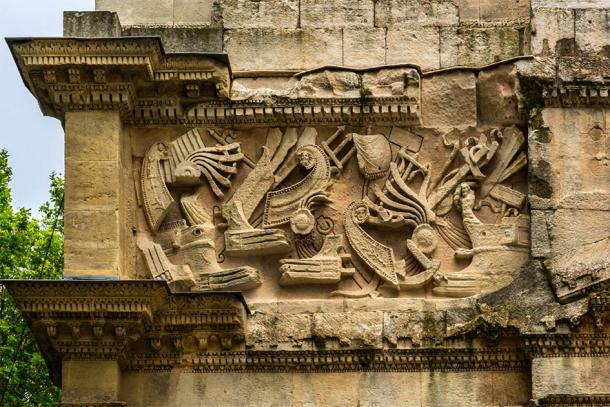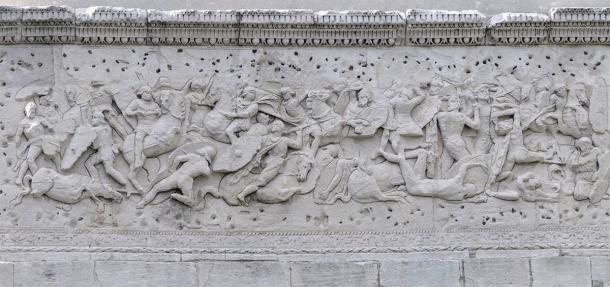The Romans left behind remarkable monuments and their influence on architecture cannot be overstated. Many of their public monuments commemorated a military victory and sought to legitimize their rule. A particularly distinctive, and immediately recognizable design is the triumphal arch, which has been used through the centuries to modern times by various nations. One of the finest examples of a Roman triumphal arch is the example in Orange, in the southeast of France.
History of the Triumphal Arch of Orange: Symbol of Victory and War
After Julius Caesar conquered Gaul in 50 BC, the town fell into decline. However, it became prosperous under the reign of Augustus (27 BC-14 AD), as Orange had been settled by ex-legionnaires who had served in the Gallic Wars.
The triumphal arch was built to honor the veterans of Caesar’s conquest of Gaul and to serve as everlasting propaganda immortalized in stone. Augustus also built other public works, such as the nearby theatre, to develop the region and more importantly to proclaim the might of Rome .

Naval battle depicted on the Triumphal Arch of Orange, one of the largest and the oldest Triumphal Arch of Roman Gaul, France ( dbrnjhrj / Adobe Stock)
Tiberius, the successor of Augustus, rebuilt the original arch to commemorate the victories of Germanicus in Germany, which avenged their disastrous defeat in 9 AD at Teutoberg Forest. Interestingly it is believed that the Romans so liked the arch that they began to model other arches on it, including ones built in the Eternal City , as Rome was called by the Roman poet Tibullus in the 1st century BC.
Orange prospered for many centuries because of its rich hinterland and distance from the borders and barbarian raiders. However, in the 5 th century AD, the Visigoths sacked Orange during the twilight years of the Western Roman Empire. The arch was not damaged but at some point some of its reliefs were damaged and lost.

Detail of a sculpted panel on the Triumphal Arch of Orange. ( CC BY-SA 4.0 )
During the Middle Ages , the citizens of Orange integrated the arch into the walls of the city. It was the northern entrance to the city, and this may have spared it from demolition. In the 18 th century, it inspired many French architects interested in classical architecture. The arch was first studied in 1850, and later became a national monument. In 1983 the arch was awarded the prestigious status of a UNESCO World Heritage site and has been restored many times down the years.
Description of Triumphal Arch, Orange, France
The monument consists of three rounded archways framed by four Corinthian columns . The central arch is larger than the ones on either side. The rectangular entablature, with its high cornice and architrave, tops the free-standing structure. It occupies a ¼ of a hectare and today is set in a green space and is 65 feet high (20m), 65 feet (20m) long and 26 feet wide (8m).
The triumphal arch was built to impress and the facades were adorned with reliefs depicting scenes from wars such as mighty naval battles, Romans battling barbarians, and a portrait of a stalwart Roman soldier holding a shield. The detailed artwork stands as a testament to the skills of the sculptors.
Originally constructed using blocks of limestone that were placed on each other without mortar, later restoration works have caused the stonework to lose some of its authenticity. There are several holes on the structure, reputedly the result of the arch being used as a target by medieval crossbowmen.
Visiting the Triumphal Arch and Orange in France
The triumphal arch is located in the old town of Orange. There is no charge to view the monument and it is possible to walk around it and witness its remarkable carving, although some of the reliefs are too high to be seen clearly. It is a great site for photographs and people enjoy taking photographs at night when the arch is lit up. Because of the lights, many of the reliefs are easier to see after dark.

Ancient Roman Theatre of Orange, France. ( dbrnjhrj / Adobe Stock)
The arch is situated not far from other wonderful medieval monuments or the famous Roman-era theatre, which is still used as a venue for concerts and theatrical performances.
Top image: Roman triumphal arch in Orange, France Source: lic0001 / Adobe Stock
By Ed Whelan
References
Mladenović, D. (2013). Arausio (Orange) . The Encyclopedia of Ancient History
Available at: https://scholar.google.com/scholar?hl=en&as_sdt=0%2C5&q=triumphal+arch+orange+&btnG=
Mustard, W. P. (1907). Roman Remains in Southern France . Classical World, 1, 12
Available at: https://search.proquest.com/openview/46b1d7f9ce48a05a3c130781a0fd59f7/1?cbl=1817329&pq-origsite=gscholar
Reyman-Lock, D. (2014). The Triumphal Arches of Gallia Narbonensis: Iconography, Boundary and Identity . Environment, Space, Place, 6(2), 31-68
Available at: https://www.ceeol.com/search/article-detail?id=290979
Related posts:
Views: 0
 RSS Feed
RSS Feed

















 September 25th, 2020
September 25th, 2020  Awake Goy
Awake Goy 



 Posted in
Posted in  Tags:
Tags: 
















